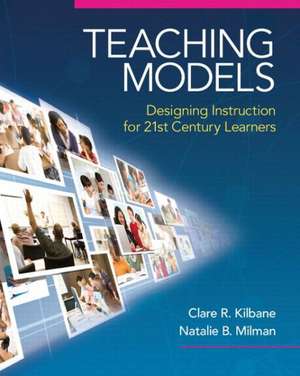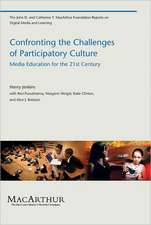Teaching Models: Designing Instruction for 21st Century Learners: New 2013 Curriculum & Instruction Titles
Autor Clare R. Kilbane, Natalie B. Milmanen Limba Engleză Paperback – mar 2013
Preț: 749.60 lei
Preț vechi: 973.50 lei
-23% Nou
Puncte Express: 1124
Preț estimativ în valută:
143.46€ • 148.20$ • 119.39£
143.46€ • 148.20$ • 119.39£
Carte disponibilă
Livrare economică 05-19 martie
Preluare comenzi: 021 569.72.76
Specificații
ISBN-13: 9780205609970
ISBN-10: 020560997X
Pagini: 504
Dimensiuni: 203 x 251 x 18 mm
Greutate: 0.79 kg
Ediția:New.
Editura: Pearson
Seria New 2013 Curriculum & Instruction Titles
ISBN-10: 020560997X
Pagini: 504
Dimensiuni: 203 x 251 x 18 mm
Greutate: 0.79 kg
Ediția:New.
Editura: Pearson
Seria New 2013 Curriculum & Instruction Titles
Notă biografică
Clare Kilbane has worked with learners at all educational levels (from graduate school to grade school) for over 20 years. A former elementary educator and technology coordinator, Clare has a bachelors degree from the University of Dayton, a masters degree in Instructional Design from The Ohio State University and a Ph.D. in Educational Evaluation from the University of Virginia. She has been on the faculty at the University of Massachusetts Amherst, Capital University, and is currently an Associate Professor of Educational Technology at Otterbein University. Clare has an active consulting practice with K-12 schools, is a frequent speaker at professional conferences, and has participated in numerous state-wide grants and research projects involving technology integration and digital portfolios. She is the co-author of the Digital Teaching Portfolio Handbook and Digital Teaching Portfolio Workbook with Natalie Milman and has authored many other articles, online courses, and multimedia materials. She lives with her husband, daughter and two Glen of Imaal terriers in Columbus, Ohio. Natalie B. Milman, Ph.D., is Associate Professor of Educational Technology and Coordinator of the Educational Technology Leadership Program in the Department of Educational Leadership at The George Washington University's Graduate School of Education and Human Development. She earned her doctorate in Instructional Technology from the University of Virginia's Curry School of Education with a graduate specialization designed to prepare technology leaders. She has taught at the elementary school level as a second grade, a science specialist, mentor, and technology teacher in Los Angeles County, California. Her primary research interest is 21st century pedagogies. Her current research interests include one-to-one laptop and tablets initiatives, student engagement and learning through distance education, strategies and models for the effective integration of technology into the curriculum at all academic levels, and the use of digital portfolios for professional development. She has published numerous articles and presented at many conferences. She has co-authored two books about digital portfolios. She is the co-editor of the Current Practices Section of the journal, Contemporary Issues in Technology and Teacher Education, and is on the AERA Technology committee. She has also served as an officer in two AERA SIGs: 1) Technology as an Agent of Change in Teaching and Learning (past Chair, Program Co-Chair, Secretary/Treasurer) and 2) Portfolios and Reflection in Teaching and Teacher Education (past Chair, Secretary/Treasurer, and Program Chair; Webmaster). She lives in Virginia, outside of Washington, D.C., with her husband and two children.
Cuprins
PART I Chapter 1: Teacher as Educational Designer Chapter 2: Instructional Design, Educational Design and Designing Effective Instruction Chapter 3: Instructional Tools for Educational Designers: Models, Strategies and Technologies Chapter 4: Classroom-Based Assessment in the 21st Century PART II: INSTRUCTIONAL MODELS Chapter 5: The Direct Instruction Model Chapter 6: The Concept Attainment Model Chapter 7: The Concept Development Model Chapter 8: The Inductive Model Chapter 9: The Vocabulary Acquisition Model Chapter 10: The Inquiry Model Chapter 11: The Cooperative Learning Model Chapter 12: The Integrative Model Chapter 13: The Problem-based Learning Model Chapter 14: The Socratic Seminar Model
Textul de pe ultima copertă
This book is focused on helping educators design effective instruction that successfully addresses the individual and shared learning needs of the diverse population of students in today s dynamic, fast-paced, technology-driven, global society. In it the authors show when and how to use the unprecendented variety of powerful teaching resources available, and how to coordinate their use to best prepare students for the education and workforce demands in their futures. The authors emphasize the teacher s role as an educational designer who approaches instructional planning with intention, uses knowledge of specialized systematic processes to identify and frame instructional challenges related to learners and content, and competently addresses those challenges by skillfully applying a broad repertoire of instructional models, strategies, and technologies.
From the Foreword by Carol Ann Tomlinson .
"A book like this one creates in me a sense of longing to begin my work as a teacher again armed with its insights How much more purposeful might my instructional choices have been How many more students might I have reached if someone had illustrated for me how to attend to students learning differences as I planned lessons? And how much more motivating might the learning opportunities I created for my students have been had there also been opportunity and guidance for using contemporary technologies to engage my students thinking, and my own? I d sign up in an instant to go back to that first year and begin again if I could take that sort of knowledge with me."
Carol Ann Tomlinson, William Clay Parrish, Jr. Professor & Chair for Educational Leadership, Foundations, & Policy Curry School of Education at the University of Virginia Also from Clare R. Kilbane and Natalie B. Milman: 0137155875 - What Every Teacher Should Know About: Creating Digital Teaching Portfolios, 1/e - (c)2009 0205393713 The Digital Teaching Portfolio Workbook: Understanding the Digital Teaching Portfolio Process, 1/e - (c)2004 0205343457 The Digital Teaching Portfolio Handbook: A How-To Guide for Educators, 1/e - (c)2003"
- Part I explains the ways in which functioning as an educational designer leads to more successful teaching.
- Part II presents 10 powerful, proven models of teaching and demonstrates how they can be transformed for new relevance in the digital era and used to address the challenges of 21st century teaching.
From the Foreword by Carol Ann Tomlinson .
"A book like this one creates in me a sense of longing to begin my work as a teacher again armed with its insights How much more purposeful might my instructional choices have been How many more students might I have reached if someone had illustrated for me how to attend to students learning differences as I planned lessons? And how much more motivating might the learning opportunities I created for my students have been had there also been opportunity and guidance for using contemporary technologies to engage my students thinking, and my own? I d sign up in an instant to go back to that first year and begin again if I could take that sort of knowledge with me."
Carol Ann Tomlinson, William Clay Parrish, Jr. Professor & Chair for Educational Leadership, Foundations, & Policy Curry School of Education at the University of Virginia Also from Clare R. Kilbane and Natalie B. Milman: 0137155875 - What Every Teacher Should Know About: Creating Digital Teaching Portfolios, 1/e - (c)2009 0205393713 The Digital Teaching Portfolio Workbook: Understanding the Digital Teaching Portfolio Process, 1/e - (c)2004 0205343457 The Digital Teaching Portfolio Handbook: A How-To Guide for Educators, 1/e - (c)2003"
















